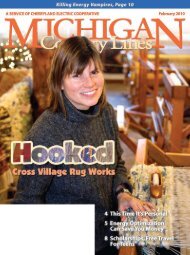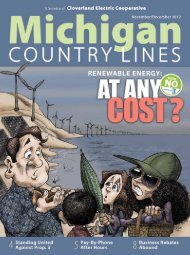Cherryland Electric Cooperative - Michigan Country Lines Magazine
Cherryland Electric Cooperative - Michigan Country Lines Magazine
Cherryland Electric Cooperative - Michigan Country Lines Magazine
You also want an ePaper? Increase the reach of your titles
YUMPU automatically turns print PDFs into web optimized ePapers that Google loves.
on the market are CFLs. The technology<br />
operates the same as fluorescent lighting in<br />
offices or kitchens, and the bulbs are now<br />
available in a wide array of colors (some can<br />
be dimmed). Always check the package to<br />
make sure a bulb meets your needs.<br />
Schuellerman adds that CFLs are generally<br />
best when used where lighting is left on for<br />
extended periods and full brightness is not<br />
immediately necessary, such as family rooms,<br />
bedrooms, and common areas. As with all<br />
fluorescent bulbs, each CFL contains a small<br />
amount of mercury (five times less than a<br />
watch battery) and should be recycled. Many<br />
retailers offer free CFL recycling; visit epa.<br />
gov/cfl for details.<br />
The final choice (remember the fireflies?) is<br />
LEDs. Although still developing, you can find<br />
LED lights, recessed fixtures, and some lower<br />
wattage replacement bulbs on store shelves.<br />
“LEDs are the up-and-coming solution,”<br />
predicts Schuellerman.”As they come down<br />
in price, homeowners will embrace them.<br />
Currently, most residential LEDs are used<br />
for outdoor lighting where fixtures are left<br />
on for extended periods and changing bulbs<br />
is not easily done. LEDs are also great for<br />
linear applications like under cabinet lighting,<br />
where light sources with thin profiles<br />
are needed.”<br />
The LEDs are more expensive than other<br />
options: a replacement for a 60-W incandescent<br />
bulb costs between $30 and $60. But<br />
costs will fall as manufacturers respond to<br />
growing consumer demand.<br />
For example, in 2008 LEDs comprised<br />
10 percent of the output from CREE Inc.,<br />
a Durham, N.C-based lighting manufacturer.<br />
Fast-forward three years and LEDs are<br />
responsible for 70 percent of the company’s<br />
business, and bulb efficiency has doubled.<br />
Innovations like a new production line last<br />
year are driving costs down.<br />
However, LEDs are not without their<br />
problems—they have to stay cool to operate<br />
efficiently, and when several bulbs are placed<br />
together for a brighter, more consumerfriendly<br />
light, lifespan decreases. However,<br />
many manufacturers are accounting for this<br />
by adding cooling elements to LED bulbs.<br />
Some bulbs feature a spine designed to allow<br />
air to flow around the base; others have fans<br />
built into the ballast.<br />
Can You See a Difference?<br />
Some consumers believe more efficient bulbs<br />
won’t provide the same “warm” look and feel<br />
as classic bulbs, but Schuellerman disagrees.<br />
“Lighting technologies are advancing at<br />
such a rate that consumers won’t notice a<br />
marked difference in the color of light from<br />
different technologies or how that light is<br />
dispersed. You also won’t necessarily see a<br />
difference in bulb shape. Some consumers<br />
don’t like the look of twist-shaped CFLs,<br />
for example, so we offer covered CFLs that<br />
look just like incandescent bulbs. We also<br />
have an LED bulb that is a replacement for<br />
a 40-watt incandescent, as well as halogen<br />
bulbs, that both are housed in incandescentshaped<br />
shells.”<br />
The difference will be found on your<br />
monthly electric bill—more efficient bulbs<br />
use between 25 and 80 percent less energy<br />
than traditional incandescents, and last much<br />
longer. The U.S. Department of Energy<br />
claims each household can save $50 a year by<br />
replacing 15 traditional incandescent bulbs.<br />
“With these new technologies, homeowners<br />
will be spending less on electricity bills<br />
for lighting and changing fewer bulbs,” says<br />
Schuellerman.<br />
Visit energysavers.gov/lighting to explore<br />
lighting options. For details on the change<br />
and other tips, visit ftc.gov/lightbulbs.<br />
Sources: U.S. Department of Energy, U.S.<br />
Energy Information Administration, Federal<br />
Trade Commission, <strong>Cooperative</strong> Research<br />
Network, LUMEN Coalition, GE, Sylvania,<br />
Philips<br />
Sources<br />
n Full Text of EISA 2007:<br />
http://frwebgate.access.gpo.gov/cgi-bin/<br />
getdoc.cgi?dbname=110_cong_public_<br />
laws&docid=f:publ140.110<br />
n FTC on Lighting Label:<br />
ftc.gov/opa/2011/06/lightbulbs.shtm<br />
n Information from GE gelighting.com/2012<br />
n NEMA Lighting Brochure:<br />
nema.org/prod/lighting/upload/Lighting_<br />
Options_for_Your_Home_brochure_4web.pdf<br />
n Refrigerator efficiency:<br />
http://apps1.eere.energy.gov/news/progress_alerts.cfm/pa_id=413<br />
n U.S. Department of Energy:<br />
As of Jan. 1, 2012, traditional 100-watt incandescent<br />
lightbulbs will no longer meet<br />
efficiency standards and be unavailable at<br />
most stores. As of Jan. 1, 2013, traditional<br />
75-watt incandescent bulbs will no longer<br />
be available; 40 and 60-watt versions will be<br />
unavailable as of Jan. 1, 2014.*<br />
* The act specifically limits the import or manufacture<br />
of inefficient bulbs. Stores will be able<br />
to sell remaining inventory.<br />
September 2011 | 13

















